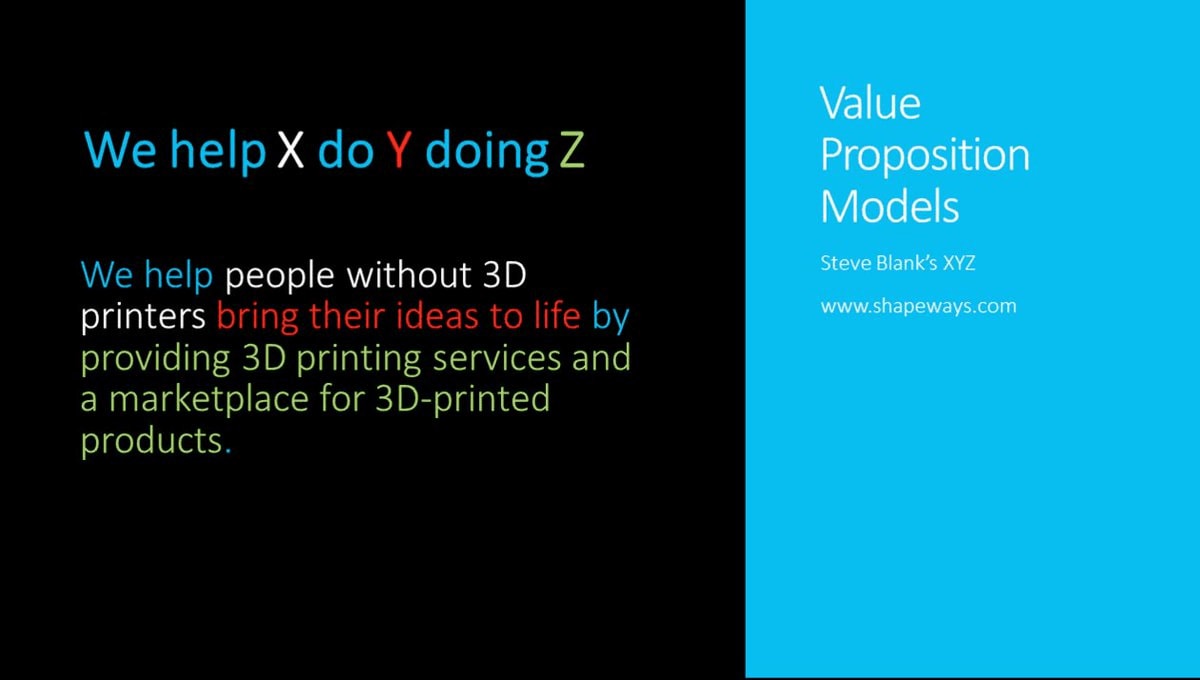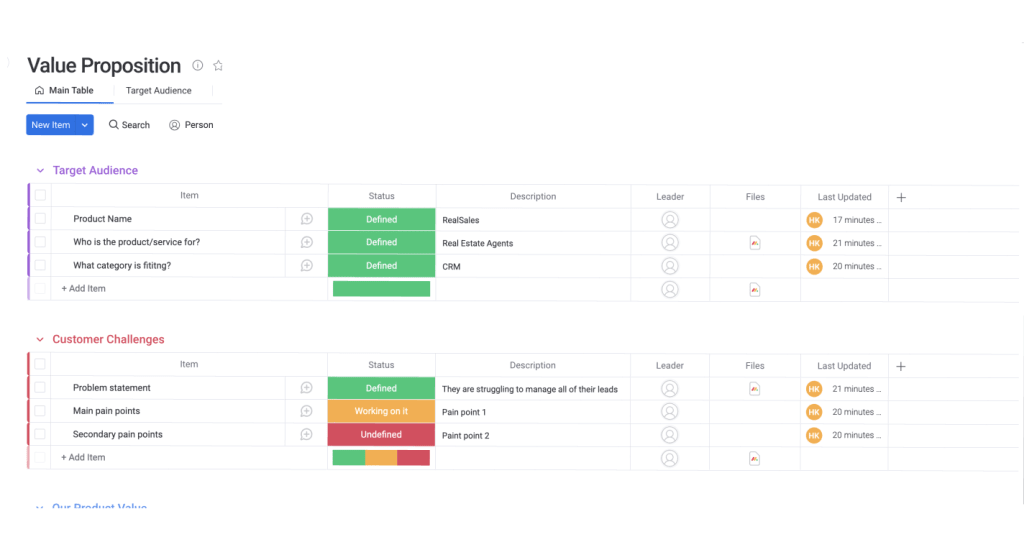Value proposition templates provide businesses with a framework for showing potential customers exactly how their company solves customer pain points.
In this article, you’ll learn why using a template is so crucial to the value proposition development process and draw inspiration from three powerful examples from industry experts. Plus, we’ll share a free value proposition template built on the monday.com Work OS to get you up and running right away. Let’s get started.
What is a value proposition template?
One of the most important aspects of building and marketing a new business is a Unique Value Proposition — UVP — also known as a Unique Selling Proposition or Point — USP. An effective value proposition concisely and compellingly explains the key benefits your business offers its target customers. In doing so, it effectively differentiates your products and services from existing alternatives — that is, your competitors.
A value proposition template is a step-by-step framework that helps digital marketers and small business owners create a great value proposition that resonates with their target market.Let’s look more closely at how value proposition templates can be so helpful for a business.
Why use a value proposition template?
Imagine for a moment that you’re the head of marketing at a new startup and you’re in charge of creating value propositions and positioning statements for a new product release. Without a value proposition template to guide you, this is a pretty daunting mountain to climb. How many words should the UVP be? What should it include? What do other companies’ UVPs sound like?
You probably know what your business does, how you do it, and maybe even why, but you struggle to put that into words, much less a concise phrase that sums your value up neatly and compellingly.
But when you use a value proposition template like the kind we’re about to discuss, the whole game changes. Now, you’ve got a powerful framework to follow, helping you to not only save time, but to draw on the expertise of hundreds of other businesses and marketing experts who’ve been in your shoes before.
That’s because the best value proposition templates have been crafted by leading experts like Geoffrey Moore, esteemed management consultant and author of startup cult classic Crossing the Chasm.
So when you use one of these templates that’s been tried, tested, reviewed, edited, and re-tested, you can quickly craft a captivating value proposition your team can turn into marketing materials such as social media campaigns.
There are a few different ways to write a value proposition statement. As various business leaders develop them, you may find it helpful to develop several UVPs using each of the frameworks and then settle on the one that suits your company style best. You may want to begin by looking into different types of templates.
What are some examples of value proposition templates?
Not every template will work for you—that’s why we pulled a few different value proposition templates that will help you decide what’s best.
Venture Hacks’ high concept pitch template
This value proposition template comes from Venture Hacks, an online resource hub for startup founders. This one’s a fairly simple concept. Take an existing company that has completely disrupted its industry — Tesla, for example. Then, determine the term that best describes your business domain — if you’re in PR, you might choose the term “communications.”
So, your UVP would be “Tesla of communications.” The idea behind this value proposition framework is that you’re leveraging the success of the business you’re referencing, thereby implying that your intention is to follow a similar path.

Geoffrey Moore’s value proposition template
This value proposition template comes from Geoffrey Moore, the author, business consultant, and organizational expert we referenced earlier. It’s a more in-depth framework than most value proposition templates, which lends itself to longer statements that give more context around what your company does and why.
The framework asks five questions:
- Who is your company, product, or service for?
- What challenges are they facing?
- What is your product name?
- What is your product category?
- What is the benefit your product offers?
For example, a CRM for real estate agents might answer these questions as follows:
- Who is your company, product, or service for? Real estate agents
- What challenges are they facing? Struggling to manage all of their leads
- What is your product name? RealSales
- What is your product category? CRM
- What is the benefit your product offers? Helps agents manage all of their contact in a centralized location
Then, we put all of that into words. For real estate agents struggling to manage all of their leads, RealSales is the CRM that helps agents manage all of their contacts in a centralized location.

Steve Blank’s XYZ framework
Our last value proposition template is from Steve Blank, an entrepreneur, educator, and author. His approach is more simple — we help X do Y by doing Z, where X is your target audience, Y is the goal or problem they want to solve, and Z is the method by which you achieve it.
Following our real estate CRM example, the XYZ framework would give us a value proposition statement that sounds like this: “We help real estate agents manage their leads more effectively by providing a centralized location from sales communications.”

Now we’ll take a look at the monday.com approach to creating user value propositions.
The monday.com Work OS value proposition template
Our value proposition template follows the Geoffrey Moore framework, as it’s the most robust process for developing a value proposition that covers all of the necessary bases.
However, unlike the majority of value proposition templates, ours is built on monday.com workdocs, a truly collaborative work space that will allow your entire team to develop the ultimate USP.

As monday.com’s latest building block, workdocs, lets your team:
- manage, share, and work on ideas in real-time without disturbing your team members or collaborators.
- boost collaboration and productivity with live objects that update in real time whenever the data changes.
- embed any monday.com object, such as widgets, charts, and views into documents so that all team members stay updated.
- tag users to communicate directly and in-context.
- assign tasks to individuals.
- connect data from existing monday.com boards, such as customer testimonials, to help you understand key pain points.
- work on the go with an intuitive and user-friendly mobile app for every device.
What’s more, because our workdocs template is built on the monday.com Work OS, it seamlessly connects with your task management board, allowing you to delegate responsibilities— such as conducting customer interviews—to your colleagues without having to leave the workdoc.
Using this example, if you create a to-do on the workdoc—whether it’s the customer interviews, edits, feedback, and so on—you can directly link it to the board, where it will appear as an action item. This seamlessly connects the workdoc with your overall workflow, giving you a view of all your assignments in one place.
If you’ve never designed a value proposition template before, we’ve got you covered.
Value proposition template tips & tricks
Check out these tips and tricks before you dive in to make sure you get the most out of our free template.
Conduct thorough audience research
A major component of developing a compelling value proposition is understanding key customer pain points. Interview your existing customers — as well as current leads in your sales pipeline and ask: “what challenges do you face, or have you faced, that our product helps to solve?”
Understand your competitors’ value propositions
Research your competitors and understand how they communicate their value. What are they saying about customer pain points? How are they describing their features and benefits?
Determine what differentiates your product or service
What is it that differentiates your company from competitors? Understanding their value propositions helps you ensure your USP separates you from the crowd, but this must be grounded in truth. What does your product or service do for your customers that nobody else does?
Turn features into benefits
Don’t simply list the features of your product — describe the benefits. So, if you’re a real estate CRM, don’t just list that you offer a VoIP dialer, but describe how the customer benefits from that feature — click to call, no network fees, etc.
Leverage message testing to refine your value proposition
If you’ve got the time and budget, there are many great message testing tools out there — like Wynter — to help you determine whether your value proposition is effective before you start using it in all of your marketing and sales materials.
FAQs about value proposition templates
How do you write a value proposition?
In order to write a value proposition, you need to have a strong understanding of three aspects of your company:
- Who your ideal customer is
- What pain points the customer has
- How your company solves that problem, and any benefits gained
Then, follow the For, Who, Our, Is, That framework:
For [target audience] who [are dealing with a pain point], our [product or service name] is [product category] that [how your product or services solves for the pain point].
What is a good value proposition statement?
A good value proposition statement speaks to the challenges your target audience is facing and concisely summarizes how your company helps solve those challenges.
For example, for marketing agencies to communicate ROI to their clients, our marketing analytics and reporting suite automatically generates compelling, data-driven, beautiful reports that show your customer exactly how you’re helping them win.
What is Amazon’s value proposition?
Amazon’s value proposition is “Fast delivery, convenience, choice, low prices.”
What is Nike’s value proposition?
Nike offers four value propositions: accessibility, innovation, customization, and brand/status.

